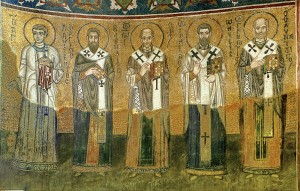From Defenders of the Catholic Faith
 Today we are in Capernaum where Jesus said: “Eat My Flesh and Drink My Blood.” I thought it appropriate that I post this challenge today.
Today we are in Capernaum where Jesus said: “Eat My Flesh and Drink My Blood.” I thought it appropriate that I post this challenge today.
A man sent a challenge saying “the Fathers of the Church limited the Eucharist to a symbol and therefore it is NOT the Real Presence of Christ.”
Is that true? My friend Gary Michuta answers the question.
Thanks for including me in on this conversation. Brian, there are three issues that commonly trip up non-Catholics when they read the early fathers on the Eucharist.
The first obstacle is their inability to understand the difference between a complimentary statement and a contradictory statement. For example, the two following statements can be complementary (that is both true in the same manner and time):
1) This ball is red2) This ball is round.
A contradictory statement cannot be true in the same manner and at the same time. for example:
1) This ball is red2) This ball is NOT red
When an early father says that Eucharist is a symbol, it is not necessarily contradictory since the Eucharist can be both a symbol and the reality of Christ’s body and blood. A statement that would contradict Catholic teaching would be The Eucharist is ONLY a symbol.
This brings up the second stumbling block. Catholic teaching on the Eucharist is much more complex than saying it is Christ’s body and blood (as you know). It is a Sacrament, which is a visible sign (symbol, type, figure) that points to an invisible reality (Christ Himself). Many non-Catholics are surprised that the Catholic Church teaches that the Eucharist is a symbol (in regards to the Sacramental species or its outward appearances).
The Council of Trent, for example, said, “This, indeed, the most Holy Eucharist has in common with the other sacraments, that is a “symbol of a sacred thing and a visible form of an invisible grace (DS 1639). It elsewhere says that Christ “offered to the Father His own body and blood under the species of bread and wine, and under the symbols of those same things gave to the apostles… so that we might partake.” (DS 1740).
The old Roman Catechism (the Catechism of the Council of Trent) speaks in the same way. When the early Fathers speak of the Eucharist in terms of its species (mode in which it is given to us), it is correct to use terms like symbols, figures, types, and the like. However, when one is speaking about the invisible reality of the Eucharist (Christ Himself) we cannot speak of it as a symbolic (see DS 1651).
 The third stumbling block, which this author seems totally oblivious, is the fact that the early Fathers interpreted Scripture according to a four-fold sense (literal, allegorical, moral and anagogical). Protestantism recognizes only one sense of Scripture, the literal (ala the Westminster Confession, 1, 9). There were schools in the ancient Church that specialized on these different senses. Antioch was known for its literal interpretations. Alexandria was known for its allegorical interpretations.
The third stumbling block, which this author seems totally oblivious, is the fact that the early Fathers interpreted Scripture according to a four-fold sense (literal, allegorical, moral and anagogical). Protestantism recognizes only one sense of Scripture, the literal (ala the Westminster Confession, 1, 9). There were schools in the ancient Church that specialized on these different senses. Antioch was known for its literal interpretations. Alexandria was known for its allegorical interpretations.
It’s not surprising that the two examples the author gives as being most surprising to Catholics are Clement and Origen. What a shock! They both taught in Alexandria and both are known for their allegorical interpretation. The quotes he gives shows very clearly that they are not talking about the literal sense of Christ’s words, but the allegorical (or perhaps moral/spiritual sense). But this sense tells us nothing about what the Eucharist truly, literally, is.
The Eucharist is both a symbol and IS what it symbolizes.
No comments:
Post a Comment
Comments are subject to deletion if they are not germane. I have no problem with a bit of colourful language, but blasphemy or depraved profanity will not be allowed. Attacks on the Catholic Faith will not be tolerated. Comments will be deleted that are republican (Yanks! Note the lower case 'r'!), attacks on the legitimacy of Pope Leo XIV as the Vicar of Christ, the legitimacy of the House of Windsor or of the claims of the Elder Line of the House of France, or attacks on the legitimacy of any of the currently ruling Houses of Europe.